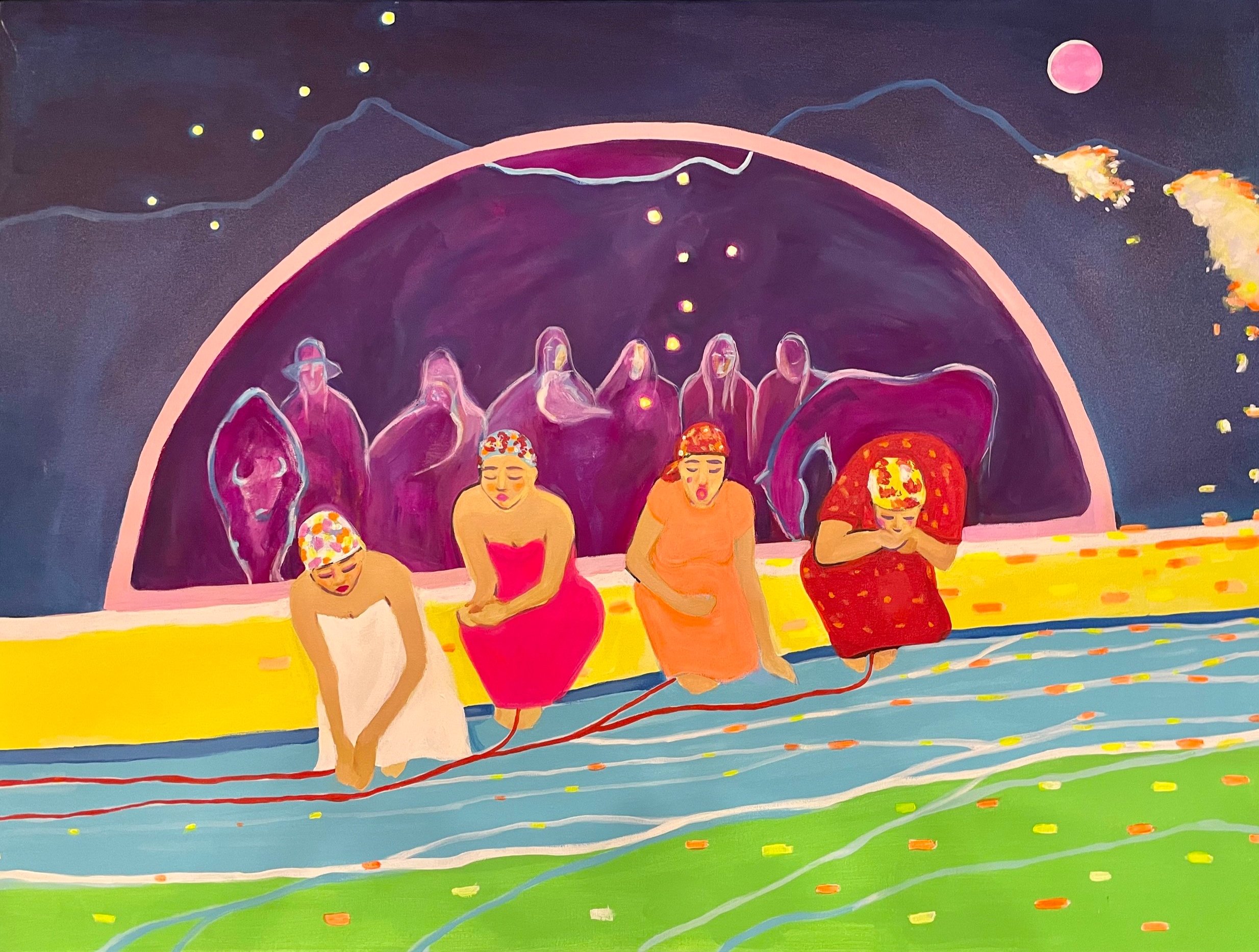
"waciy nipîy" (mountain water)
This is an artistic collaboration between visual storyteller Lana Whiskeyjack from Saddle Lake Cree Nation and water expert and Global Water Futures director John Pomeroy. Together, they have provided a beautiful visual reflection on the health of mountain water systems and the interconnections with all living beings.
Lana Whiskeyjack
iskotêw mena nipîy
Acrylic painting, 30”x40”
I was struck by John’s research on the health and wellbeing of our mountain water, especially in regard to the impacts of mining and forest fires on our water systems. In our nêhiyaw worldview, we see the mountains as our close relatives that carry our stories and strength. The mountains have been an important part of our spirituality and ceremonies. This acrylic painting was my initial unedited response of sadness and anger of the violent correlation between the severity of our mountain water and women’s bodies. Our iskwêwak (women) are the keeper of our sacred water, within their bodies and for all water systems on these lands of our past and future ancestors. This painting reflects how extractive industries creates a ripple effect of detrimental changes on the biodiversity and biome of the waters within the land and women’s bodies that will have severe consequences on future generations.
“There are six seasons and 13 moons (months) in nêhiyaw itâpisiniwin (Cree worldview). Each season is connected to the state of the waters, from freezing to flowing, and how it brings life to all living beings. In my original acrylic painting, I painted the unhealthy state of our mountain waters and how it is reflected through the bodies of our iskwêwak (women). For this exhibit, I wanted to evolve that grief into prayers for the health and wellbeing of the sacred waters that include the birth of our future generations.” – Lana Whiskeyjack
“When I look at the painting, I see the long-intertwined history of the river, the people, the animals, and the mountain, valley, forests, and sky. But also, a present where the tie between people and the river is threatened by fires in the mountain, and drought in the valley, symptomatic of climate change. It seems that there is a link between the elders of the past, the buffalo and the horse and perhaps a shield for the people (women) of the present who use the river and are tied to the river. The colours portray hope despite the threat in the mountains.” – John Pomeroy
Lana Whiskeyjack
Ayîkipîsim – Frog Moon (April)
Oil painting, 91x122cm
From a scientific perspective it ties into the resilience we see in many mountain streams despite the tremendous impacts of climate change on hydrological processes. However, it also alludes to the further and more dramatic hydrological change that can come from increased wildfire, with burned lands producing more runoff, especially during flood conditions and from increased rainfall and large storms. And it shows that hope is never lost and that future climates are partly chosen by people and that we still have time to choose our future.
For more information about the science.
Behind the Exhibit: "waciy nipîy" (mountain water)
“I really appreciated the conversation I had with John, and the important scientific research data he shared with me that I continue to process through my cultural and matriarchal lens. I keep thinking about how could Indigenous ways of knowing and being support and work alongside the important research work like John’s, to restore balance to the unbalanced state of our important relatives of the mountains and water systems? How can our Treaty laws help to bring wahkohtowin (kinship) consciousness to industries and governmental bodies? I appreciated the collaboration with John expertise of being able edit and transform his important scientific knowledge and research through an iskwêw visual story. I think it told an important story of resilience and a vision to work towards.” - Lana Whiskeyjack
Dr. Lana Whiskeyjack, from Saddle Lake Cree Nation, brings her leadership and knowledge in nêhiyaw (Cree) arts-based practices, community-engaged research and scholarship into her role as an assistant professor in the Women’s and Gender Studies Department, Faculty of Arts, University of Alberta. She is a graduate from the iyiniw pimâtisiwin kiskeyihtamowin doctoral program at University nuhelot’įne thaiyots’į nistameyimâkanak Blue Quill, a former Indian Residential School attended by two generations of her womb connections. Her decolonizing learning and being at UnBQ grounded within nêhiyaw (Cree) ceremony, nêhiyawêwin (Cree language) and nêhiyaw worldview is foundational to her creativity, research, teaching and community service practices. Her current research projects explores issues around the theme of (re)connecting to the spirit of nêhiyawêwin; nêhiyaw diverse gender worldviews and rites of passage; and, the iskwêwêwin (womanhood) relation to the celestial and Mother Earth within 13 moon teachings. Dr. Whiskeyjack is featured in a documentary“Lana Gets Her Talk” (2017) that explores how she uses art as ceremony in confronting and transcending historical trauma and reconciliation.
Professor John Pomeroy is a Distinguished Professor in the Dept. of Geography & Planning, the Canada Research Chair in Water Resources and Climate Change, the Director of the Global Water Futures Programme, and the Director of the University of Saskatchewan Coldwater Laboratory in Canmore (Alberta, Canada). His current research interests are on the impact of land use and climate change on cold regions hydrology and water quality, and improved prediction of climate change impacts, especially floods and droughts.
Contact Us!
Want to share your comments, questions or perspectives on this gallery and the themes explored? Please Contact Us!
The Virtual Water Gallery team is committed to providing a safe, respectful, harassment-free, and accessible space for all. We do not tolerate harassment of any member of society.



